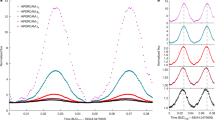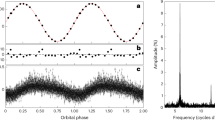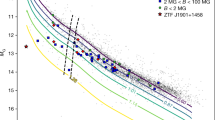Abstract
White dwarfs are the burnt-out cores of Sun-like stars and are the fate of 97 per cent of the stars in our Galaxy. The internal structure and composition of white dwarfs are hidden by their high gravities, which causes all elements apart from the lightest ones to settle out of their atmospheres. The most direct method of probing the inner structure of stars and white dwarfs in detail is via asteroseismology. Here we present a pulsating white dwarf in an eclipsing binary system, enabling us to place extremely precise constraints on the mass and radius of the white dwarf from the lightcurve, independent of the pulsations. This 0.325-solar-mass white dwarf—one member of the SDSS J115219.99+024814.4 system—will serve as a powerful benchmark with which to constrain empirically the core composition of low-mass stellar remnants and to investigate the effects of close binary evolution on the internal structure of white dwarfs.
This is a preview of subscription content, access via your institution
Access options
Access Nature and 54 other Nature Portfolio journals
Get Nature+, our best-value online-access subscription
$29.99 / 30 days
cancel any time
Subscribe to this journal
Receive 12 digital issues and online access to articles
$119.00 per year
only $9.92 per issue
Buy this article
- Purchase on Springer Link
- Instant access to full article PDF
Prices may be subject to local taxes which are calculated during checkout





Similar content being viewed by others
Data availability
The raw (https://bit.ly/2T5nDKn) and reduced (https://bit.ly/3a94M6E) X-shooter data presented in this paper are available from the European Southern Observatory. Raw and reduced HiPERCAM data are available from the Gran Telescopio Canarias here: https://bit.ly/2T5f9mu. These data can also be obtained from the corresponding author upon reasonable request.
Code availability
The X-Shooter reduction pipeline (version 3.2.0) is available at https://www.eso.org/sci/software/pipelines/xshooter/ and the HiPERCAM pipeline at https://github.com/HiPERCAM/hipercam. The lightcurve-fitting method is available at https://github.com/trmrsh/cpp-lcurve. The codes used to generate the plots presented in this paper are available from the corresponding author upon reasonable request.
References
Maxted, P. F. L. & Marsh, T. R. The fraction of double degenerates among DA white dwarfs. Mon. Not. R. Astron. Soc. 307, 122–132 (1999).
Nelemans, G., Yungelson, L. R. & PortegiesZwart, S. F. The gravitational wave signal from the Galactic disk population of binaries containing two compact objects. Astron. Astrophys. 375, 890–898 (2001).
Tutukov, A. V. & Yungelson, L. R. On the influence of emission of gravitational waves on the evolution of low-mass close binary stars. Acta Astron. 29, 665–680 (1979).
Webbink, R. F. Double white dwarfs as progenitors of R Coronae Borealis stars and type I supernovae. Astrophys. J. 277, 355–360 (1984).
Paczyński, B. Gravitational waves and the evolution of close binaries. Acta Astron. 17, 287 (1967).
Iben, Icko Jr., Tutukov, A. V. & Yungelson, L. R. On the origin of hydrogen-deficient supergiants and their relation to R Coronae Borealis stars and non-DA white dwarfs. Astrophys. J. 456, 750 (1996).
Han, Z., Podsiadlowski, P., Maxted, P. F. L. & Marsh, T. R. The origin of subdwarf B stars— II. Mon. Not. R. Astron. Soc. 341, 669–691 (2003).
Nelemans, G. The Galactic gravitational wave foreground. Class. Quant. Gravity 26, 094030 (2009).
Marsh, T. R. Double white dwarfs and LISA. Class. Quant. Gravity 28, 094019 (2011).
Nomoto, K. & Kondo, Y. Conditions for accretion-induced collapse of white dwarfs. Astrophys. J. Lett. 367, L19–L22 (1991).
Parsons, S. G. et al. Testing the white dwarf mass-radius relationship with eclipsing binaries. Mon. Not. R. Astron. Soc. 470, 4473–4492 (2017).
Fontaine, G. & Brassard, P. The pulsating white dwarf stars. Publ. Astron. Soc. Pacif. 120, 1043 (2008).
Winget, D. E. & Kepler, S. O. Pulsating white dwarf stars and precision asteroseismology. Annu. Rev. Astron. Astrophys. 46, 157–199 (2008).
Althaus, L. G., Córsico, A. H., Isern, J. & García-Berro, E. Evolutionary and pulsational properties of white dwarf stars. Astron. Astrophys. Rev. 18, 471–566 (2010).
Charpinet, S., Brassard, P., Giammichele, N. & Fontaine, G. Improved seismic model of the pulsating DB white dwarf KIC 08626021 corrected from the effects of neutrino cooling. Astron. Astrophys. 628, L2 (2019).
Clemens, J. C., O’Brien, P. C., Dunlap, B. H. & Hermes, J. J. Seismology of an ensemble of ZZ Ceti stars. In 20th Eur. White Dwarf Workshop—Astronomical Society of the Pacific Conference Series Vol. 509 (eds Tremblay, P. E., Gaensicke, B. & Marsh, T.) 255 (ASP, 2017).
Zenati, Y., Toonen, S. & Perets, H. B. Formation and evolution of hybrid He-CO white dwarfs and their properties. Mon. Not. R. Astron. Soc. 482, 1135–1142 (2019).
Córsico, A. H., Althaus, L. G., MillerBertolami, M. M. & Kepler, S. O. Pulsating white dwarfs: new insights. Astron. Astrophys. Rev. 27, 7 (2019).
Córsico, A. H. & Althaus, L. G. Pulsating low-mass white dwarfs in the frame of new evolutionary sequences. I. Adiabatic properties. Astron. Astrophys. 569, A106 (2014).
Bell, K. J. et al. Pruning the ELM survey: characterizing candidate low-mass white dwarfs through photometric variability. Astrophys. J. 835, 180 (2017).
Pyrzas, S. et al. Discovery of ZZ Cetis in detached white dwarf plus main-sequence binaries. Mon. Not. R. Astron. Soc. 447, 691–697 (2015).
Hermes, J. J. et al. Insights into internal effects of common-envelope evolution using the extended Kepler mission. Mon. Not. R. Astron. Soc. 451, 1701–1712 (2015).
Hallakoun, N. et al. SDSS J1152+0248: an eclipsing double white dwarf from the Kepler K2 campaign. Mon. Not. R. Astron. Soc. 458, 845–854 (2016).
Vernet, J. et al. X-shooter, the new wide band intermediate resolution spectrograph at the ESO Very Large Telescope. Astron. Astrophys. 536, A105 (2011).
Dhillon, V. et al. First light with HiPERCAM on the GTC. In Ground-based and Airborne Instrumentation for Astronomy VII—Society of Photo-Optical Instrumentation Engineers (SPIE) Conference Series 107020L (SPIE, 2018).
Copperwheat, C. M. et al. Physical properties of IP Pegasi: an eclipsing dwarf nova with an unusually cool white dwarf. Mon. Not. R. Astron. Soc. 402, 1824–1840 (2010).
Rasmussen, C. E. & Williams, C. K. I. Gaussian Processes for Machine Learning (MIT Press, 2006).
Koester, D. White dwarf spectra and atmosphere models. Mem. Soc. Astron. Ital. 81, 921–931 (2010).
Scargle, J. D. Studies in astronomical time series analysis. II. Statistical aspects of spectral analysis of unevenly spaced data. Astrophys. J. 263, 835–853 (1982).
Kilic, M. et al. A refined search for pulsations in white dwarf companions to millisecond pulsars. Mon. Not. R. Astron. Soc. 479, 1267–1272 (2018).
Marsh, T. R., Dhillon, V. S. & Duck, S. R. Low-mass white dwarfs need friends—five new double-degenerate close binary stars. Mon. Not. R. Astron. Soc. 275, 828 (1995).
Bours, M. C. P. et al. Precise parameters for both white dwarfs in the eclipsing binary CSS 41177. Mon. Not. R. Astron. Soc. 438, 3399–3408 (2014).
Bours, M. C. P., Marsh, T. R., Gänsicke, B. T. & Parsons, S. G. HST+COS spectra of the double white dwarf CSS 41177 place the secondary inside the pulsational instability strip. Mon. Not. R. Astron. Soc. 448, 601–605 (2015).
Istrate, A. G. et al. Models of low-mass helium white dwarfs including gravitational settling, thermal and chemical diffusion, and rotational mixing. Astron. Astrophys. 595, A35 (2016).
PradaMoroni, P. G. & Straniero, O. Very low-mass white dwarfs with a C-O core. Astron. Astrophys. 507, 1575–1583 (2009).
Han, Z., Tout, C. A. & Eggleton, P. P. Low- and intermediate-mass close binary evolution and the initial-final mass relation. Mon. Not. R. Astron. Soc 319, 215–222 (2000).
Tremblay, P. E., Kalirai, J. S., Soderblom, D. R., Cignoni, M. & Cummings, J. White dwarf cosmochronology in the solar neighborhood. Astrophys. J. 791, 92 (2014).
Press, W. H., Teukolsky, A. A., Vetterling, W. T. & Flannery, B. P. Numerical Recipes. The Art of Scientific Computing 3rd edn (Cambridge Univ. Press, 2007).
Foreman-Mackey, D., Hogg, D. W., Lang, D. & Goodman, J. emcee: the MCMC hammer. Publ. Astron. Soc. Pacif. 125, 306 (2013).
Holberg, J. B. & Bergeron, P. Calibration of synthetic photometry using DA white dwarfs. Astron. J. 132, 1221–1233 (2006).
Tremblay, P. E., Bergeron, P. & Gianninas, A. An improved spectroscopic analysis of DA white dwarfs from the Sloan Digital Sky Survey data release 4. Astrophys. J. 730, 128 (2011).
Claret, A. Non-linear limb-darkening law for LTE models. VizieR 336, 31081 (2000).
Gianninas, A., Strickland, B. D., Kilic, M. & Bergeron, P. Limb-darkening coefficients for eclipsing white dwarfs. Astrophys. J. 766, 3 (2013).
Foreman-Mackey, D., Agol, E., Ambikasaran, S. & Angus, R. Fast and scalable Gaussian process modeling with applications to astronomical time series. Astron. J. 154, 220 (2017).
Fontaine, G., Brassard, P. & Bergeron, P. The potential of white dwarf cosmochronology. Publ. Astron. Soc. Pacif. 113, 409–435 (2001).
GaiaCollaboration et al. Gaia Data Release 2. Summary of the contents and survey properties. Astron. Astrophys. 616, A1 (2018).
Schlafly, E. F. & Finkbeiner, D. P. Measuring reddening with Sloan Digital Sky Survey stellar spectra and recalibrating SFD. Astrophys. J. 737, 103 (2011).
Lenz, P. & Breger, M. Period04 user guide. Comm. Asteroseismol. 146, 53–136 (2005).
Hermes, J. J. et al. White dwarf rotation as a function of mass and a dichotomy of mode line widths: Kepler observations of 27 pulsating DA white dwarfs through K2 campaign 8. Astrophys. J. Suppl. 232, 23 (2017).
Bailer-Jones, C. A. L., Rybizki, J., Fouesneau, M., Mantelet, G. & Andrae, R. Estimating distance from parallaxes. IV. Distances to 1.33 billion stars in Gaia data release 2. Astron. J. 156, 58 (2018).
Panei, J. A., Althaus, L. G., Chen, X. & Han, Z. Full evolution of low-mass white dwarfs with helium and oxygen cores. Mon. Not. R. Astron. Soc. 382, 779–792 (2007).
Acknowledgements
S.G.P. acknowledges the support of a Science and Technology Facilities Council Ernest Rutherford Fellowship. HiPERCAM and V.S.D. are funded by the European Research Council under the European Union’s Seventh Framework Programme (FP/2007-2013) under ERC-2013-ADG grant agreement number 340040 (HiPERCAM). Partial support for this work was provided by NASA K2 Cycle 6 Grant 80NSSC19K0162. A.G.I. acknowledges support from the Netherlands Organisation for Scientific Research. This work is based on observations made with the Gran Telescopio Canarias (programme ID GTC59-18B), installed in the Spanish Observatorio del Roque de los Muchachos of the Instituto de Astrofísica de Canarias, on the island of La Palma, and also based on observations made with the European Southern Observatory telescopes at the La Silla Paranal Observatory under programme ID 097.D-0786.
Author information
Authors and Affiliations
Contributions
All authors contributed to the work presented in this paper. S.G.P. reduced all the spectroscopic and photometric data and carried out the SED fitting. S.G.P. and V.S.D. performed the Gran Telescopio Canarias observations. A.J.B. performed the radial-velocity and lightcurve fitting. S.P.L. wrote the Python code that implemented the Gaussian processes in the lightcurve fitting. V.S.D., S.P.L., T.R.M., S.G.P., E.B., M.J.D., M.J.G. and D.I.S. all contributed to the development and support of HiPERCAM. J.J.H. analysed the pulsations in the HiPERCAM lightcurves. A.G.I. investigated the internal structure of the white dwarfs and the evolution of the binary. All authors reviewed the manuscript.
Corresponding author
Ethics declarations
Competing interests
The authors declare no competing interests.
Additional information
Peer review information Nature Astronomy thanks Alejandro Córsico, Ingrid Pelisoli and the other, anonymous, reviewer(s) for their contribution to the peer review of this work.
Publisher’s note Springer Nature remains neutral with regard to jurisdictional claims in published maps and institutional affiliations.
Supplementary information
Rights and permissions
About this article
Cite this article
Parsons, S.G., Brown, A.J., Littlefair, S.P. et al. A pulsating white dwarf in an eclipsing binary. Nat Astron 4, 690–696 (2020). https://doi.org/10.1038/s41550-020-1037-z
Received:
Accepted:
Published:
Issue Date:
DOI: https://doi.org/10.1038/s41550-020-1037-z



